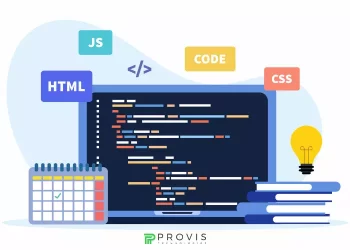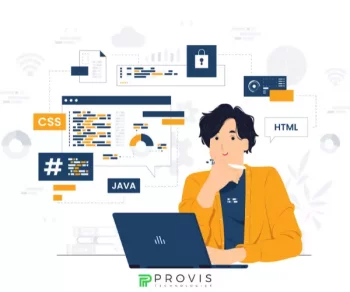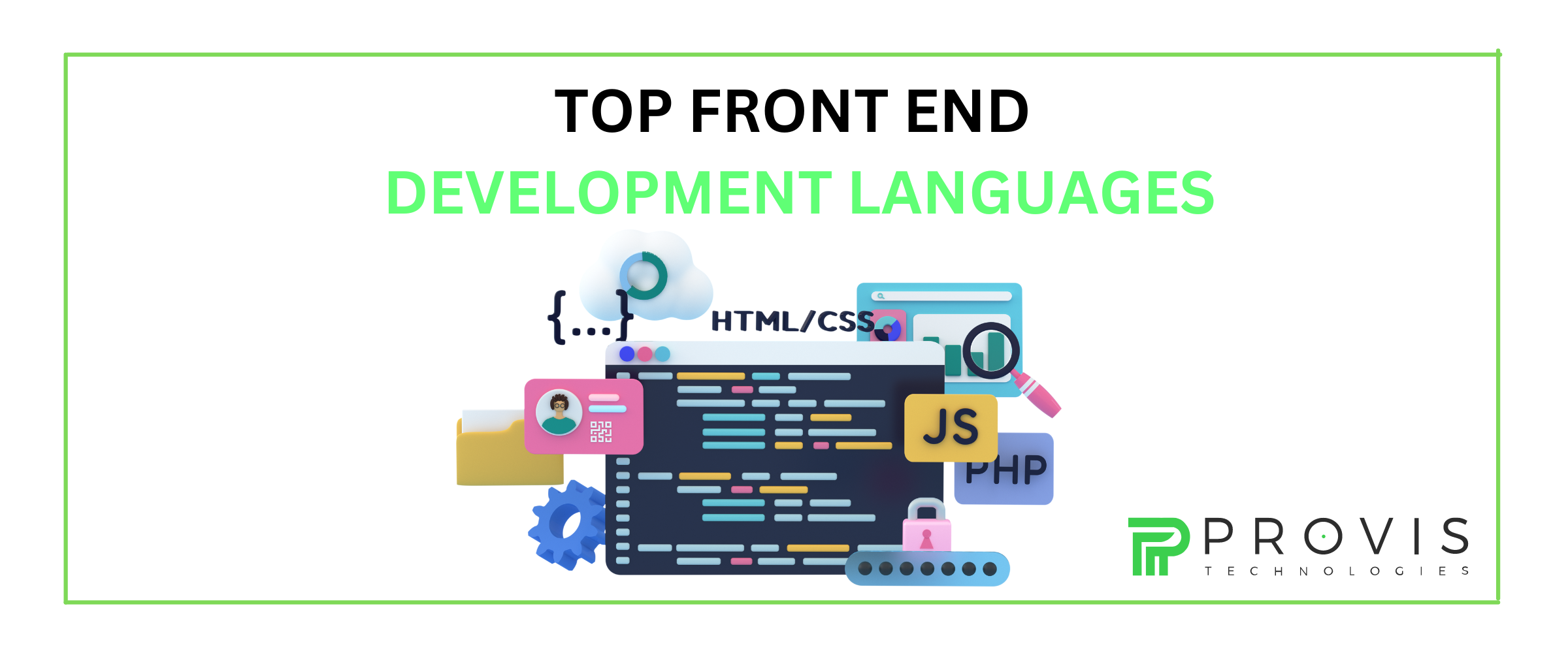Whenever we open a website, we first notice where the features and functions are. A successful business requires a clean, structured, attractive website for a great user experience. And all this depends on front-end programming languages.
Various things go behind the scenes in creating a robust and visually appealing application.
Your front end defines how the application will appear to the end users.
An unstructured website creates an unsightly appearance. On the other hand, effective front-end development leaves a lasting first impression.
The front-end programming languages affect the user experience. It can lead to good as well as bad experiences. It is crucial to pick the best one that fits your requirements.
But before stepping further, it is important to understand front-end development.
Also Read: How to Choose a Mobile App Development Framework: A Beginner’s Guide
Front End Development

The first page, functions, and features result from front-end development whenever we open an app or website. It focuses on client-facing features. Front-end development comprises the user interface, visual aspects of the app, and resolving the errors users face.
It involves the development of front-end features that are ultimately going to be viewed by the end users.
Nowadays, the front-end development process is more straightforward than before. Some platforms simplify the development process by providing pre-built templates. As front-end developers understand what end-users need, they serve as a bridge between designers and front-end developers.
Front-end developers are responsible for styling, alignment, images, text, navigation, colors, etc. Regardless of screen size and different browsers, developers ensure a pleasant user experience. A developer should know how and where to use the photos.
A good website with a good front-end design makes it more convenient for users.
Front-end development is crucial for the success of a business.
Related Blog: Top 10 Mobile Usability Issues and Solutions to Fix Them
Here are some front-end development languages.
Top Front-End Programming Languages
-
React
A front-end component-based JavaScript framework built by Facebook. It is an open-source framework that follows the Model View Controller (MVC) architecture. React is mainly used for single-page applications and mobile apps.
It is easy to create interactive UIs in React. The web applications in React are created using reusable components.
The applications made in React can handle complex updates effortlessly. Instead of writing long codes, you can write small and reusable files. In addition, React is quite easy to learn because it requires much less understanding of JavaScript and HTML.
React is a scalable and flexible platform. It can easily handle large programs conveniently. Facebook supports it. It is a simple programming language, and the biggest advantage is the Virtual DOM, which helps optimize the structure.
Features –
- A minimal understanding of HTML is required
- Server-side rendering makes the app faster
- It lets you create smaller and more reusable files
- A reliable tool for website development
- It builds high-performance apps
- Supported by a larger community
2. JavaScript
It is the world’s most famous programming language. The program in this language is known as a script. JavaScript is dynamic and lightweight and is used as part of web pages. Its lightweight nature makes it faster than other languages.
Its primary motive is to enhance user interaction.
It is primarily known as object-oriented programming, mainly used for web development, game development, mobile app development, and web servers. It adds functionality to the pages with its Document Object Model. The DOM helps in modifying the HTML pages.
Don’t Miss: Top 10 Tips to Reduce App Development Costs
This front-end development language lets users add advanced web page features. Some of the many amazing qualities are cross-browser interoperability and excellent speed.
Features –
- It provides rich interfaces for a great user experience
- It is an object-centred scripting language like Visual Basic
- Client edge technology
- It uses third-party add-ons to extend the functionality
- It offers a lot of flexibility
3. Vue
A lightweight JavaScript framework for building user interfaces (UIs) and single-page applications. It is an open-source framework that utilizes a model-view-view model architecture. The MVVM architecture focuses on the view model layer. With two-way data binding, it synchronizes model and view layers.
It comes with two options for data binding that is one way and two-way data binding.
The two-way data binding simplifies the creation of single-page applications and web apps. In addition, the directives provided by Vue.js permit developers to extend HTML.
The core library of Vue.js is based on HTML, CSS, and JavaScript. This lightweight model allows fast rendering. In addition, it provides component reusability as the code is easy to understand and read, which makes it easy to handle.
Must Know: Creating Mobile Web Apps the Right Way Advice & Methods
Features –
- The framework provides flexibility and robustness
- Easy to understand
- Active community support
- Well-structured documentation
- A powerful set of tools
- Supports two-way communication

4. Cascading Style Sheets
It modifies documents written in markup languages. It gives the content a structure. CSS makes pages dynamic and presentable. It converts documents into a consumable format to make them easier to understand.
Code written in CSS can be used for various HTML pages, saving time. In addition, it provides easy editing of codes to modify the style, along with subsequent updates regarding any changes.
Although it is a style sheet, it is also known as a top front-end language. It is popular for its easy maintenance, time savings, text effects, and layout. In addition, it helps the developers make the website the way they want.
Also Read: A Complete Checklist to Build a Secure Mobile App
Features –
- Easy to maintain and saves time
- It gives structure to the content
- Changing web standards
- Support graphic development
5. Angular
The structural framework is used for creating dynamic web applications. This framework can create rich internet applications. It is open source and completely free.
Angular is the best framework for building large-scale, high-performance, easy-to-maintain web applications. It provides command-line tools that assist developers in developing and deploying apps faster. In addition, multiple tools are available to help developers start the development project seamlessly.
Whether you want to create a full set or single page application, Angular creates clean and maintainable. It gives functionality with even shortcodes. Compared to other platforms, Angular is a comprehensive and responsive framework. In addition, the applications created with Angular are mobile-friendly and run on all major browsers.
Related Blog: Top 8 Programming Languages for Mobile App Development
Features –
- Great speed and high performance
- Supported by Google
- Supports single-page applications
- Pre-configured Environment
- Simple and consistent
To Sum Up
This blog mentioned the most recommended and popular front-end programming languages. A website should keep the attention of the users. The points a developer should consider are effective, structured, and attractive websites.
An unstructured development might create disinterest in the user’s mind. An aesthetically pleasing website is a must to attract users. Make sure the language you choose adds to your growth.
Written By
Author's Picks
- What is Progressive Web Apps: Comprehensive Guide for 2025
- 20/11/2024
- Why Your Business Needs a Mobile App Trends & Statistics
- 19/10/2023
- How to Choose a Mobile App Development Framework: A Beginner’s Guide
- 26/08/2024
Categories
- AI for Startups
- AI in Web Development
- AI Integration
- AI Platforms
- AI Prompt
- AI Tools
- AI Trading Software
- Android App
- Android vs iOS Development
- Angular
- API
- API Development
- App
- app development
- App Idea
- App User Feedback
- Application
- Artificial Intelligence
- Audit Services
- Automotive Industry
- Awards and Recognition
- Business Consulting
- Business Website
- Chatbots
- CRM
- CRM for Financial Advisors
- Custom CRM
- Custom SaaS
- Custom Website
- Customer Service
- dashboard design
- Developing a Mobile App
- Digital Business
- E-commerce
- EMR Integration
- Finance
- Financial Advisors
- Financial Advisors
- GIT
- Health Insurance
- iOS App
- iOS App Development
- IoT Mobile App Development
- IoT Platforms
- IT Audit Services
- IT Consulting
- IT Strategies
- Java Development
- Laravel
- Lean Canvas
- Learning Management System
- Logistics Apps
- Mobile App Development
- MVP
- Native App
- News Aggregator Site
- OTT
- Outsourcing IT
- Payment Gateway
- predictive analysis
- Product Launch Strategy
- Progressive Web App (PWA)
- Prototype
- Recommender Systems
- Ruby
- SaaS
- SaaS Application
- SaaS Business
- SaaS Company
- SaaS Development
- SaaS Product
- SaaS Project
- Sales Funnel
- SEO
- Shopping Cart
- Software Development
- SSL and TLS
- Startup Checklist
- Technology
- Tetradic Color Scheme
- UI/UX Design Company
- Unit Testing
- User Flow
- User Testing
- Web Development
- Web Performance Optimization
- website Maintenance Services
- Website Migration Service
- Website Speed Optimization
- WooCommerce
- WordPress





